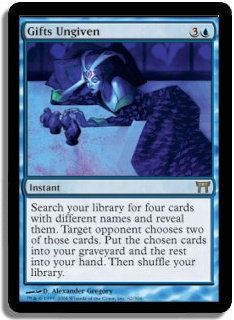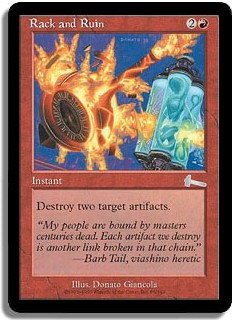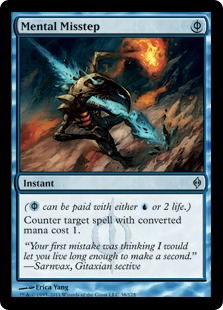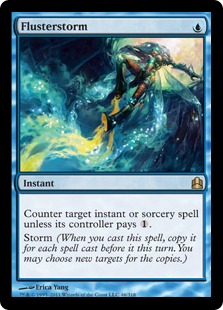I’ll be honest. I spend most of my time playing Standard and Modern, but they are not my favorite formats. It’s definitely Vintage. There are a lot of misconceptions about Vintage, such as that it is luck-based and random. A good friend of mine often challenges people to a game of Vintage, but instead of getting out a deck he just pulls out a couple of six-sided dice and says, "High roll?" In my experience, Vintage is incredibly skill intensive if you are playing a deck that allows it to be. The mulligan decisions are more complicated than simply looking for a curve and sufficient lands. The number of Tutors gives you an enormous amount of options, and the free spells are both hard to play and hard to play around.
While I have a great love for the format, I don’t own a full set of power. My ability to play in sanctioned tournaments is restricted a lot by my ability to borrow these cards. For this reason, I don’t play Vintage often. This past weekend, however, I was able to borrow the cards I was missing to play in an event. With first place being a Mox Emerald, I felt that it would be well attended. I had been aware of the event for some time and had sourced the cards I needed well in advance. I decided to tune my list as much as possible with the help of a few friends and a bunch of late night testing sessions.
I don’t try to build new decks for Vintage solely because of how skill intensive I believe the format to be. I would rather play a tuned list of whatever the best Dark Confidant deck is and play the best I can. Fortunately, my testing started shortly after Gen Con, where a Bob deck took first place at the Vintage Championship.
Creatures (8)
Planeswalkers (2)
Lands (15)
Spells (35)
- 1 Sensei's Divining Top
- 1 Brainstorm
- 2 Mana Drain
- 2 Lightning Bolt
- 1 Vampiric Tutor
- 1 Mystical Tutor
- 1 Yawgmoth's Will
- 4 Force of Will
- 1 Sol Ring
- 1 Demonic Tutor
- 1 Hurkyl's Recall
- 1 Time Walk
- 1 Ancestral Recall
- 1 Mana Crypt
- 1 Time Vault
- 1 Merchant Scroll
- 1 Tinker
- 1 Voltaic Key
- 1 Black Lotus
- 1 Mox Emerald
- 1 Mox Jet
- 1 Mox Pearl
- 1 Mox Ruby
- 1 Mox Sapphire
- 1 Nihil Spellbomb
- 3 Mental Misstep
- 2 Flusterstorm

It had been over a year since I last played Vintage. In this time, Flusterstorm, Snapcaster Mage, Mental Misstep, and Grafdigger’s Cage had all been printed. Since all of these cards were in Lanigra’s winning list, my priority in testing was to evaluate these cards myself and work out which of them belong in the deck.
I wanted to make a couple of changes right off the bat. I have always disliked Sensei’s Divining Top, as it is mana intensive and often clunky. I replaced it with Gifts Ungiven, a card I can never leave out of any Vintage deck. It is quite expensive and is super hard to play, but it will usually win you the game when used properly.
I also wanted a Rack and Ruin over a Lightning Bolt. I’ve always liked Lightning Bolt a lot in Vintage, although it hasn’t really been widely accepted as powerful enough. I think it is the perfect removal spell for a number of reasons. These reasons are Jace, the Mind Sculptor, Dark Confidant, and Lodestone Golem. There isn’t another one-cost spell that can take care of the key cards in the best two decks. Since it’s terrible against Oath and Dredge, I was pretty happy with one in the main and as many more as I could jam in the sideboard.
Rack and Ruin, on the other hand, is less versatile and harder to cast but is much higher impact. Taking out two mana sources or a Time Vault and its Key can just win games in the mirror. It will pick off something relevant, including your own Mana Crypt if your life total is running dangerously low. The card is a game winner in a lot of situations against Stax, although its high cost prevents you from playing more than one.
I had some general reservations about the list. Against Stax, the sideboard plan of four Ingot Chewers, a Mountain, and a Lightning Bolt seemed great. However, a maindeck with only 23 mana sources and five dead cards in Flusterstorm and Mental Misstep was a little sketchy. Lanigra did have two Lightning Bolts and a Hurkyl’s Recall in the main, but I didn’t feel that made up for its weaknesses. I knew that I wanted to replace a couple of the counters with Spell Pierce. Spell Pierce felt like a better all-around card, as I have had a lot of success with it in the past before the printing of Mental Misstep and Flusterstorm. I didn’t know which of the new counters was better, and that meant testing them against other decks.
Against Dredge, it doesn’t really matter all that much what you do in game 1. The Nihil Spellbomb is occasionally awesome if you can find it, but game 1 always heavily favors Dredge. Post-board, Mental Misstep is excellent. It counters all of their answers to your hate as well as their own Mental Missteps. Flusterstorm was great against their answers for your hate but not against their Mental Missteps.
When testing against Force of Will decks, I discovered what Flusterstorm actually does. It doesn’t counter threats; it helps you resolve them. If you were the one casting the threat, no matter what it was, Flusterstorm was better than any of the counters they had. If they were trying to resolve the threat, then it turned out to be pretty horrid.
It never countered what seemed to be the relevant cards in the matchup: Dark Confidant, Jace, the Mind Sculptor, Oath of Druids, Necropotence, or Yawgmoth’s Bargain. Even if they were going for a storm-based kill, they would use one of these in order to enable the necessary storm. This meant that they were far up enough on cards to have their own Flusterstorm to counter yours. Since Bob decks are the most controlling of the format, resolving your own threat was far less of a priority than dealing with theirs.
Mental Misstep, on the other hand, was amazing. Costing zero is so much better than one. Regardless of whether they were going for an Ancestral Recall or a Voltaic Key, you had a hard counter for it. Lightning Bolt, Sensei’s Divining Top, and even the Vampiric and Mystical Tutors are worth countering for zero mana. The more games I played, the more I wanted Mental Missteps and the less I wanted Flusterstorms.
Testing also gave me the chance to analyze Snapcaster Mage. At first, I hated him. He costs a lot of mana, most of which is colored, and his 2/1 body is quite low impact. It seemed like the deck had to play one, if only just to make Gifts Ungiven better. On the whole, I wasn’t impressed. This, however, slowly started to change. I guess it was a sample size thing. The more games I played, the more relevant it seemed. Casting Ancestral once has always been good, but casting it a second time is quite rude and usually game over. Late in the game, it also functions as a Tutor since you’ll have access to a bunch of tasty options. I didn’t really want to draw them in the multiples, so I ended up settling on two.
The mana base was something I really struggled with. The Mountain in the sideboard seemed great, which meant that I wanted to play four Scalding Tarns. The problem was that I really wanted to play a Swamp. With multiple Volcanic Islands and multiple Islands, I was often short on black. I usually play two Islands, a Swamp, and five dual lands, but I just couldn’t get that to work with four Tarns. I eventually decided to cut some targets and play eight fetchlands. It meant only having six fetchable lands, but that seemed better than having color problems regardless of whether or not they Wasteland you.
Creatures (7)
Planeswalkers (2)
Lands (16)
Spells (35)
- 1 Brainstorm
- 2 Mana Drain
- 1 Lightning Bolt
- 1 Vampiric Tutor
- 1 Mystical Tutor
- 1 Yawgmoth's Will
- 4 Force of Will
- 1 Sol Ring
- 1 Demonic Tutor
- 1 Hurkyl's Recall
- 1 Time Walk
- 1 Ancestral Recall
- 1 Mana Crypt
- 1 Time Vault
- 1 Gifts Ungiven
- 1 Merchant Scroll
- 1 Rack and Ruin
- 1 Tinker
- 1 Voltaic Key
- 1 Black Lotus
- 1 Mox Emerald
- 1 Mox Jet
- 1 Mox Pearl
- 1 Mox Ruby
- 1 Mox Sapphire
- 1 Ponder
- 2 Spell Pierce
- 1 Nihil Spellbomb
- 2 Mental Misstep
Sideboard

This is the maindeck I played, but not the sideboard. It was during the event that I worked out exactly how I wanted it to look. It was only three cards different, and it fortunately didn’t prevent me from taking first place. Figuring out what my sideboard should have looked like, on the other hand, was pretty frustrating.
Grafdigger’s Cage is super important against Oath. Oath of Druids is amazing against you, but without it their deck is just a much worse blue deck. Forbidden Orchard gives you a win condition, and they don’t have any Bobs. I was a little apprehensive about playing Cages against Dredge, as they have a lot of Mental Missteps not to mention all of their anti-hate cards. It soon became apparent that with the amount of permission you play, you could usually just protect it.
The Yixlid Jailers were there as backup, as they don’t die to Nature’s Claim or Mental Misstep. Jailers will occasionally get picked off by a Darkblast, but they will have to find one and they usually don’t play too many copies. I have been a big fan of Leyline of the Void in the past. Both Jailers and Cages will shut your opponent down, but it is potentially only temporary. Their graveyard will remain stacked if they deal with either, whereas a Leyline means they will have to start over. It is terrible to draw, and at a cost of four mana, Tutoring it up isn’t all that viable. There are a lot of pros and cons for each, but it’s the significance of Cage against Oath that had me sold.
I would only play three Ingot Chewers now instead of the four that I played in the tournament. The Stax matchup is really good, and four seems unnecessary. With extra lands and Bolt, you’ll find that you have too many cards to bring in already. I wanted an additional land on top of the Mountain, which is how Strip Mine made it in. After playing with it, I will never build my sideboard without one. You don’t need both of your basics against decks without Wasteland, and post-board one of them will get a major upgrade.
Library of Alexandria and Tolarian Academy can be very powerful in blue mage mirrors, and having a solid answer is great. You might also just be able to capitalize on a little mana screw. I even had a game where I cast a Yawgmoth’s Will just so I could Strip another of my opponent’s lands while beating him up with Fruit tokens from his Forbidden Orchard. Against the decks that are sporting Wastelands, you’ll want to side in additional lands, and every now and then it is right to Strip Mine a Mishra’s Workshop. Against Dredge, it might just win the game if they don’t have a backup Bazaar of Baghdad. The colors felt too fragile to have it in the main, but I was super excited about it when siding it in.
Stax
+3 Ingot Chewer
+2 Lightning Bolt
+1 Mountain
+1 Strip Mine
-2 Mental Misstep
-1 Gifts Ungiven
-1 Ponder
-1 Yawgmoth’s Will
-1 Nihil Spellbomb
-1 Snapcaster Mage
The basic plan is to swap your dead Mental Missteps and the more expensive spells for more mana and excellent removal. Despite cutting a lot of your card draw, it is still pretty easy to put the game away. The matchup feels too easy on the play and is still quite good on the draw.
Oath
+4 Grafdigger’s Cage
+2 Mental Misstep
+1 Strip Mine
-1 Island
-1 Nihil Spellbomb
-1 Lightning Bolt
-2 Snapcaster Mage
-1 Hurkyl’s Recall
-1 Rack and Ruin
Taking out the artifact removal and the Bolts is a no-brainer. Grafdigger’s Cage effectively switches off your Snapcaster Mages, Tinker, and Yawgmoth’s Will. You’ll take out the Snapcasters, but you’ll want to leave in the Tinker and the Will, as they will often win the game on their own provided there isn’t a Cage in play. You can also sacrifice your Cage to Tinker if it’s likely that it will win you the game.
Mirror
+2 Mental Misstep
+2 Lightning Bolt
+1 Strip Mine
-1 Hurkyl’s Recall
-1 Island
-1 Tinker
-1 Nihil Spellbomb
-1 Blightsteel Colossus
This one is tough. Tinker can win you a lot of game 1s, but there will be games where you have an incredible hand and games where you are behind and happen to get lucky. Against opposing Hurkyl’s, Jaces and assorted permission, it is a pretty low percentage play most of the time. I’ve found I have the most success without it. The Spellbomb is something I am still unsure about. I don’t want to cut it, but it is probably the weakest link. It is either that or a Mana Drain.
Dredge
+4 Grafdigger’s Cage
+2 Yixlid Jailer
+2 Mental Misstep
+1 Strip Mine
-1 Island
-2 Mana Drain
-1 Lightning Bolt
-1 Hurkyl’s Recall
-1 Rack and Ruin
-1 Yawgmoth’s Will
-2 Snapcaster Mage
This one is relatively straightforward. Yawgmoth’s Will and Snapcaster Mage are shut down by your hate. This is another point in favor of Leyline of the Void. Sideboarding here is simply just a matter of cutting terrible cards for awesome ones.
I love Vintage. It is the format that punishes you the most for your errors while rewarding you the most for great play. You will lose the occasional game to legitimate brokenness, but for the most part, the games you lose will be the ones where you were outplayed.
For those of you who haven’t yet given Vintage a chance, I urge you to try it out for yourself, and don’t write it off based upon the opinions of those who don’t play Vintage well.
As always, I eagerly await your feedback.
Dan Unwin
Sledgesliver on Magic Online
 |
I am Izzet. ‘Cause Counterburn wins everything, duh. |





